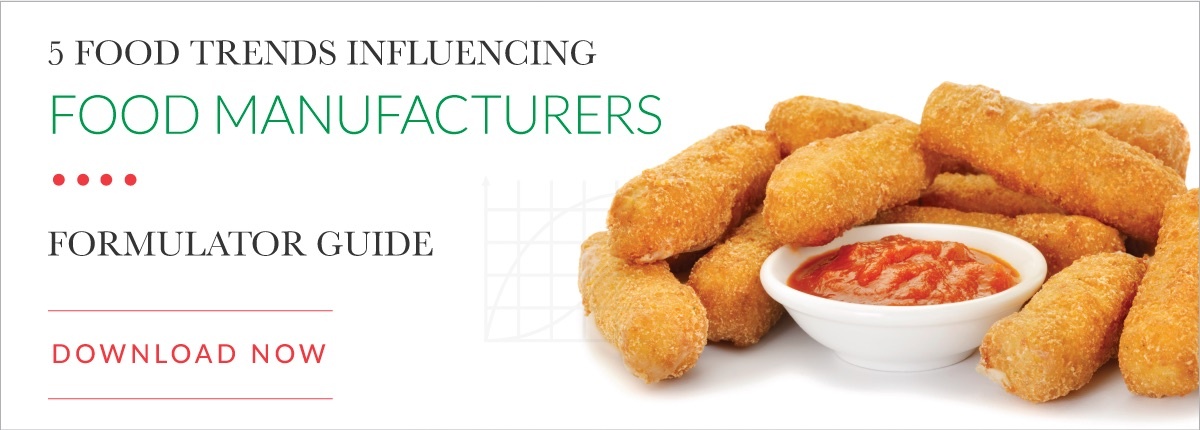 Every fall, foodies and leaders in the food industry release their predictions on next year’s food industry trends. Often, these food and flavor trends offer little value to the average food and beverage manufacturer because of their inability to scale for the masses.
Every fall, foodies and leaders in the food industry release their predictions on next year’s food industry trends. Often, these food and flavor trends offer little value to the average food and beverage manufacturer because of their inability to scale for the masses.
While exotic ingredients and sensational flavor profiles in food and drink may make for click-worthy headlines, they’re often impractical for the average consumer who simply wants a satisfying meal or snack at a price point they can afford.
We’ve gathered the data, researched what other influencers in the food and beverage industry are saying, and added our own conclusions to give you our take.
Top 2024 trends in the food and beverage industry:
- Global Flavor Combinations
- Specialty RTD Beverages
- Flavorful Soups
- Food Transparency
- Upcycled & Sustainable Ingredients
- Water Conservancy
- Convenient Experiential Dining at Home
- Truly Better-For-You Formulations
- A Return to Traditional Ingredients and Value
- Continued Supply Chain Disruption
1. Global Flavor Combinations
Some radical or exotic flavor trends make the list each year. Not surprisingly, most fade as quickly as they come on the scene. Foods that feature the fifth flavor sensation of umami, however, have been on trend for a few years. Now, innovative chefs are trending toward combining those full-bodied, satisfyingly rich notes of umami with obscure regional ingredients.
Expect to spice things up in 2024, with globally inspired seasonings, sauces and condiments. Both Asian and African flavor profiles will be in consumers’ pantries and on their plates, according to the Specialty Food Association (SFA) Trendspotter Panel.
While some exotic flavors may make their mark, without question, consumers will also reach for the familiar. Heritage and traditional foods and those reminiscent of family recipes rich in flavors, including classic comfort foods, will be on trend.
2. Specialty RTD Beverages
The global ready-to-drink beverages market size is projected to grow at a CAGR of 6.38% through 2030 — from about $750 billion in 2023 to more than $1,155 billion by the end of the forecast period.
According to SFA research, sophisticated non-alcoholic carbonated and non-carbonated beverages will continue to see growth. Coffees, teas and broths with an added boost of caffeine and functional ingredients will offer a boost of energy, clarity and focus. Salt, sugar and artificial flavors continue to fall out of flavor.
RELATED: What are Functional Ingredients? Food Scientists Weigh In
3. Flavorful Soups
Soup recipes have taken TikTok by storm, with some even dubbing the segments “SoupTok.” While TikTok is known for fleeting fads, soup has staying power, both for its savory goodness and ease of preparation, according to SFA.
Formulations that feature creamy soups can maintain their rich textures and flavors with improved nutrition and functionality by using whey protein concentrate when partially replacing fresh cream. Soup starters and mixes kept in pantries or shelves benefit from this functional powdered ingredient because it is shelf-stable and doesn’t require refrigeration.
4. Food Transparency
Where food is sourced is increasingly of interest to consumers, and they’re catching on to labeling practices that conveniently omit certain information. As an example, while a label may state that a food product is manufactured in the U.S., the ingredients may be imported from other countries, not all of which uphold the strict food safety regulations that have been established stateside.
Consumers want to know where their food comes from, how it was produced and how it was sourced, making ingredient transparency and a strict chain of custody more important than ever.
5. Upcycled and Sustainable Ingredients
Consumer awareness of upcycled foods has increased from just 10% in 2019 to more than 40% today. Among shoppers who seek out natural products, that figure rises to 60%. Even more promising for food and beverage manufacturers is the projected market growth of $80 billion by 2032. An example of upcycled food includes cacao pulp which is being upcycled into foods like jellies, jams and fruit powders.
The original upcycled food continues to gain market share. Powdered whey protein concentrate is an upcycled and sustainable food ingredient sought after by consumers. At one time, whey was discarded as part of the cheesemaking process, but is now upcycled into functional and nutritious ingredients for soups, sauces, dressings, meal replacement bars, protein supplements, beverages and more.
6. Water Conservancy
One of the leaders in food trend predictions is Whole Foods which releases its top 10 emerging food trends each year. Among them is another sustainable practice: water conservancy. Consumer interest is growing in this initiative, and food and beverage manufacturers are evaluating their production practices in response.
Consumers want healthy products that aren’t a strain on the environment. One example is the use of water extracted from discarded fruit byproducts. Even household products like laundry detergent sheets and shampoo bars are capitalizing on this trend.
7. Convenient Experiential Dining at Home
Consumers who prepare everyday foods at home will look for ways to create an upscale experience with indulgent flavors, spices and creative sides. Pre-packaged meals won’t just go from the microwave to a paper plate. Home cooks will augment these dishes to enhance flavors and visual appeal.
For example, adding a charcuterie board with fruits, vegetables, cheeses and cured meats can elevate an ordinary pre-packaged or take-out meal. Add the right lighting and background music, and they’ve created a culinary experience that feels like a special night out.
8. Truly Better-For-You Formulations
There’s been a 54% increase of “minus” products on the market, according to ADM. The demand for reduced or no fat, sugar or salt highlights how better-for-you concepts with an open and transparent view toward health will continue to dominate 2024 food trends.
Low-sodium formulations that still taste great and those that contain reduced sugar will have an upper hand. But formulators can’t resort to artificial flavors or texture modifiers to make up for the loss of flavor when these ingredients are reduced or removed.
9. A Return to Traditional Ingredients and Value
The plant-based food trend isn’t going anywhere, but studies show that plant-based protein alternatives cost more than their traditional counterparts in every major category, with some costing twice as much. When plant-based product costs are combined with the fact that they don’t taste as good as the original, it becomes a hard sell for many consumers.
What consumers really crave is value and a good meal. Whey protein continues to increase its market share and is accepted as a wholesome ingredient by the vast majority of consumers. What’s more, it allows formulators to optimize their costs and pass that value on to their customers.
10. Continued Supply Chain Disruption
Major supply chain disruptions began in spring 2020. While challenges have eased, there are still pockets of supply chain issues that result in volatile pricing and inconsistent sourcing. Maintaining consistent supply chains and inventory can help ease disruption and even out volatile pricing. In particular, Grande Custom Ingredients Group maintains a consistent and price-stable supply of its whey ingredients.
Takeaways for Food and Beverage Innovations
Ensuring availability of wholesome and flavorful ingredients that align with consumer demand is a top priority. As a functional whey protein ingredient manufacturer, Grande Custom Ingredients Group can ensure its products are ethically sourced and manufactured right here in the United States under a strict chain of custody.
Consider how the following whey protein products can improve nutrition, flavor and market share:
- Grande Bravo® — partially replaces cream and cream cheese in soups, sauces, fillings, dips, dressings and more
- Grande Gusto®— partially replaces fresh, processed or powdered cheese in cheese sauces and soups and reduces sodium
- Grande FestoTM — incorporated into meat spice blends and processed and ground meat products to enhance juiciness and increase yields up to 5% without being classified as a filler or binder
- Grande Ultra® — whey protein isolate (WPI) for use in high-protein sports, nutritional and meal replacement beverages to improve protein levels
- WPCrisp® — a light, crunchy protein crisp for use in protein bars and snack applications to improve protein levels
- Grande PrimoTM — all-natural Greek or regular yogurt powder that adds a signature tang and nutritional benefits to your creamy coatings, fillings and smoothies
Request a sample of any of these whey protein products and discuss how to incorporate them into your application and food system. Contact us today. Also check out our infographic below illustrating 5 Food Formulation Trends With Staying Power.




